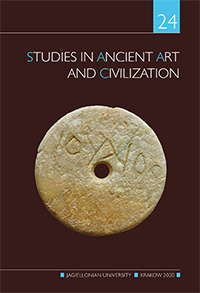Al-Jaya Palace and the New Shawbak Town. A Medieval frontier and the return of the urbanism in the Southern Transjordan
Al-Jaya Palace and the New Shawbak Town. A Medieval frontier and the return of the urbanism in the Southern Transjordan
Author(s): Guido VanniniSubject(s): Archaeology, Ancient World
Published by: KSIĘGARNIA AKADEMICKA Sp. z o.o.
Keywords: Jordan; Mission; Petra; Shawbak; Light Archaeology; incastellamento; Saladin; crusaders
Summary/Abstract: The recent discovery – made during the 2018 campaign ofthe ‘Medieval Petra’ Mission of the University of Florence – of the residential al-Jaya Palace at the bottom of the hill of Shawbak’s ‘incastellato’ site is of particular relevance both for medieval and Islamic heritage in Jordan (no architecture of a comparable quality from the Ayyubid-Mamluk periodhas ever been found in the country) and mostly for the archaeological confirmation that underneath al-Jaya, lays the ancient medieval capital city of southern Jordan, founded by Saladin, on the same site of the castle-capital of the previous Crusader Lordship of Transjordan. This result represents a triple confirmation for the scientific program of the Mission: the productivity of the ‘Light Archaeology’ methodology that characterizes our approach; the real existence of the city whose foundation we had deemed to be able to propose (owing solely to the ‘light’ reading son the walls of the ‘castle’); and the excellence of the formal level of the building – perfectly matching the quality of the political and productive structures documented earlier in the castle – that speaks of a cultured and refined city and of an extraordinary strategic project that can be attributed to Saladin’s political intelligence. A project that gave back a new centrality to the entire southern Transjordan and started a settlement and political tradition that is the basis of modern Jordan itself (it is not accidental that the first capital of the state was Ma’an). Once the urban structure that has now appeared is understood, future research will be able to direct the excavations so as to address another great historical question which 2018 investigations have highlighted: we know the birth and begin to read the life of this extraordinary town, butwhen, how and why did it perish so much so that it was forgotten by history (and to be rediscovered by archaeology)? Perhaps for the first time, we will have an opportunity to study archaeologically an aspect of the historical crisis that, probably during the 15th century, engulfed the Arab-Islamicworld, opening the way for the Ottoman conquest. It is an intriguing perspective to be addressed in tandem with a renewed public archaeology program: conservative restoration, social valorization, broad communication directed both to the local communities and to the international public with the implementation of the master plan 2010-14, and, finally, tourist routes connecting Shawbak with the Petra area.
Journal: Studies in Ancient Art and Civilization
- Issue Year: 2020
- Issue No: 24
- Page Range: 83-98
- Page Count: 16
- Language: English

